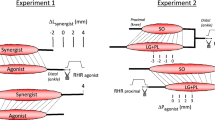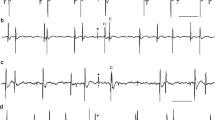Summary
In the crab's thoracic-coxal muscle receptor (T-C MRO) system, receptor motor (Rm) input to the receptor muscle (RM) results in a variety of effects on the sensory responsiveness, and hence on the reflex output of the system.
-
1.
Repetitive stimulation of the Rm nerve with the RM under isometric conditions results in T sensory fibre depolarisation, to levels which can exceed threshold for reflex activation of at least four promotor motoneurones. Both the rate and amplitude of T fibre depolarisation, and the resulting reflex frequencies, increase nearly linearly with stimulus frequency at a given RM length (Figs. 1, 2A).
-
2.
A constant frequency Rm input at increasing RM lengths results in an increase in both the rate and the level of T fibre depolarisation: thus, promoter reflex latencies are correspondingly decreased and discharge frequencies enhanced (Figs. 2B, 5A, 6, 7).
-
3.
Rm stimulation and applied RM stretch are qualitatively additive with respect to both T fibre depolarisation and reflex promotor activation (Fig. 3).
-
4.
The Rm induced reflex can be quantitatively comparable to that evoked by ramp-function stretch, since equivalent amplitude T fibre depolarisations can be effected via these two distinct routes of reflex activation (Figs. 4, 5).
-
5.
High frequency Rm input under isometric conditions can also depolarise the in-parallel S sensory fibre, possibly due to non-uniform contractility of the RM along its length. In terms of a contribution to the promotor reflex, however, the relatively small amplitude S fibre depolarisation thus evoked can probably be discounted (Fig. 4).
-
6.
A T fibre negative dynamic (hyperpolarising) response to ramp relaxation, often small or absent in de-efferented preparations, is greatly enhanced during concurrent Rm input, assuming a mirror image of the velocity sensitive positive dynamic response. During this hyperpolarisation, the promotor reflex response to the Rm input is partially or completely suppressed (Fig. 3).
-
7.
Rm activity increases sensitivity to imposed stretch in a dramatic and long-lasting manner. Brief trains of Rm stimuli can substantially lengthen the dynamic components of the sensory and reflex responses to a later stretch stimulus. The effect can be seen even in the absence of any overt sensory response to the conditioning trains, and is dependent on train frequency and duration. An optimal effect requires a minimal 1 s delay between conditioning train and test stretch (Figs. 9, 10).
-
8.
Concurrent, spontaneous bouts of activity are observed in promotor and Rm motoneurones, indicating a common central drive (Fig. 8).
Similar content being viewed by others
Abbreviations
- e.j.p. :
-
excitatory junction potential
- Pm :
-
promotor motoneurone(s)
- Rm :
-
receptor motoneurone(s)
- RM :
-
receptor muscle
- T-C MRO :
-
thoracic-coxal muscle receptor organ
References
Alexandrowicz JS, Whitear M (1957) Receptor elements in the coxal region of Decapoda Crustacea. J Mar Biol Assoc UK 36:603–628
Atwood HL (1976) Organization and synaptic physiology of crustacean neuromuscular systems. Prog Neurobiol 7:291–391
Brown MC (1967) Some effects of receptor muscle contraction on the responses of slowly adapting abdominal stretch receptors of the crayfish. J Exp Biol 46:445–458
Bush BMH (1976) Non-impulsive thoracic-coxal receptors in crustaceans. In: Mill PJ (ed) Structure and function of proprioceptors in the invertebrates. Chapman and Hall, London, pp 115–151
Bush BMH (1980) Non-impulsive stretch receptors in crustaceans. In: Roberts A, Bush BMH (eds) Neurones without Impulses. Cambridge University Press, Cambridge, pp 147–176
Bush BMH, Godden DH (1974) Tension changes underlying receptor potentials in non-impulsive crab muscle receptors. J Physiol 242:80P-82P
Bush BMH, Roberts A (1971) Coxal muscle receptors in the crab: the receptor potentials of S and T fibres in response to ramp stretches. J Exp Biol 55:813–832
Bush BMH, Godden DH, Cannone AJ (1975) Efferent gain control in a non-impulsive muscle receptor. Proc Aust Physiol Pharmacol Soc 6:32–33
Cannone AJ, Bush BMH (1980a) Reflexes mediated by non-impulsive afferent neurones of thoracic-coxal muscle receptor organs in the crab,Carcinus maenas. 1. Receptor potentials and promotor motoneurone responses. J Exp Biol 86:275–303
Cannone AJ, Bush BMH (1980b) Reflexes mediated by non-impulsive afferent neurones of thoracic-coxal muscle receptor organs in the crab,Carcinus maenas. 2. Reflex discharge evoked by current injection. J Exp Biol 86:305–331
Cannone AJ, Bush BMH (1981) Reflexes mediated by non-impulsive afferent neurones of thoracic-coxal muscle receptor organs in the crab,Carcinus maenas. III. Positive feedback to the receptor muscle. J Comp Physiol 142:103–112
Evoy WH, Cohen MJ (1971) Central and peripheral control of arthropod movements. Adv Comp Biochem Physiol 4:225–266
Fields HL (1976) Crustacean abdominal and thoracic muscle receptor organs. In: Mill PJ (ed) Structure and function of proprioceptors in the invertebrates. Chapman and Hall, London, pp 65–114
Hunt CC, Ottoson D (1976) Initial burst of primary endings of isolated mammalian muscle spindles. J Neurophysiol 39:324–330
Husmark I, Ottoson D (1971) The contribution of mechanical factors to the early adaptation of the spindle response. J Physiol 212:577–592
Kennedy D, Davis WJ (1977) Organization of invertebrate motor systems. In: Geiger SR, Kandel ER, Brookhart JM, Mountcastle VB (eds) Handbook of physiology, sect 1, vol 1/2. Am Physiol Soc, Bethesda MD, pp 1023–1087
Kuffler SW (1954) Mechanisms of activation and motor control of stretch receptors in lobster and crayfish. J Neurophysiol 17:558–574
Matthews PBC (1972) Mammalian muscle receptors and their central actions. Arnold, London
Nakajima S, Onodera K (1969) Adaptation of the generator potential in the crayfish stretch receptors under constant length and constant tension. J Physiol 200:187–204
Stein RB (1974) Peripheral control of movement. Physiol Rev 54:215–243
Wilson DM, Larimer JL (1968) The catch property of ordinary muscle. Proc Natl Acad Sci USA 61:908–916
Wilson DM, Smith DO, Dempster P (1970) Length and tension hysteresis during sinusoidal and step function stimulation of arthropod muscle. Am J Physiol 218:916–922
Author information
Authors and Affiliations
Additional information
We thank the M.R.C. and the S.R.C. (U.K.) for research grants, and Alison Walford and Barbara Riddick for help with the figures and typing. We wish to thank the anonymous referee for helpful comments on the first version of this paper.
Rights and permissions
About this article
Cite this article
Cannone, A.J., Bush, B.M.H. Reflexes mediated by non-impulsive afferent neurones of thoracic-coxal muscle receptor organs in the crab,Carcinus maenas . J. Comp. Physiol. 142, 113–125 (1981). https://doi.org/10.1007/BF00605483
Accepted:
Issue Date:
DOI: https://doi.org/10.1007/BF00605483




